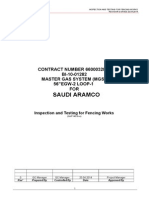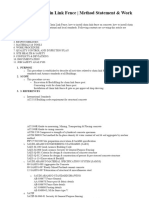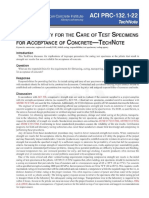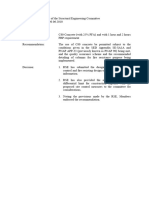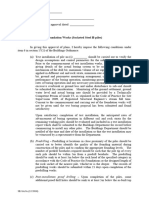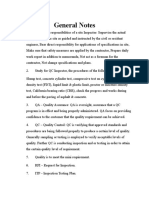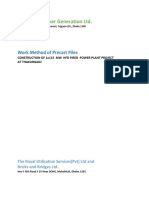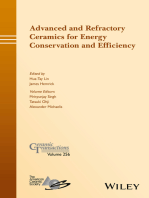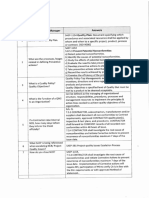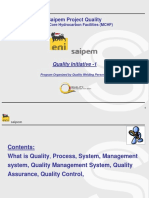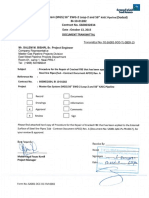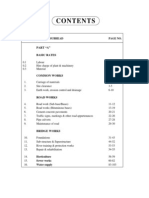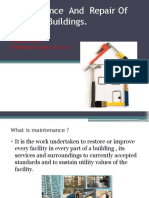P133I Concrete
P133I Concrete
Uploaded by
kbldamCopyright:
Available Formats
P133I Concrete
P133I Concrete
Uploaded by
kbldamOriginal Title
Copyright
Available Formats
Share this document
Did you find this document useful?
Is this content inappropriate?
Copyright:
Available Formats
P133I Concrete
P133I Concrete
Uploaded by
kbldamCopyright:
Available Formats
C.A.T.
GROUP QUALITY ASSURANCE
INSPECTION AND TESTING FOR CONCRETE WORKS
REVISION 0 DATED 20.04.2014
CONTRACT NUMBER 6600032833
BI-10-01282
MASTER GAS SYSTEM (MGS)
56"EGW-2 LOOP-1
FOR
SAUDI ARAMCO
Inspection and Testing for Concrete Works
(QA/P133I.Doc)
0
Rev
QC Manager
Prepared By
QC Manager
Controlled By
20.04.2014
Date
Project Manager
Approved By
C.A.T. GROUP QUALITY ASSURANCE
INSPECTION AND TESTING FOR CONCRETE WORKS
REVISION 0 DATED 20.04.2014
Table of Contents
1.
PROCEDURE NO.
2.
SCOPE AND PURPOSE
3.
APPLICABILITY
4.
RESPONSIBILITY
5.
GENERAL
6.
DEFINITIONS
7.
PROCEDURE
7.1.
Receiving Inspection
7.2.
In-process Inspection and Testing
7.2.1.
7.2.2.
7.2.3.
7.2.4.
7.2.5.
7.2.6.
7.2.7.
7.2.8.
7.3.
Civil and Earth Works
Pre-Pour Inspection
Concrete Placement
Concrete Testing
Form Removal
Concrete Curing and Protection
Finishing
Grouting
Final Inspection and Testing
8.
RECORDS
9.
REFERENCES
10.
ATTACHMENTS
C.A.T. GROUP QUALITY ASSURANCE
1.
INSPECTION AND TESTING FOR CONCRETE WORKS
REVISION 0 DATED 20.04.2014
PROCEDURE NO.
P133I
2.
SCOPE AND PROCEDURE
The scope and purpose of this procedure is to establish a functional Inspection and
Testing system to ensure that the process control of concrete works is adopted and
properly executed in accordance with Client specifications and applicable standards.
3.
APPLICABILITY
All Concrete works.
4.
RESPONSIBILITY
5.
Project Manager
Discipline Engineer
Discipline Foreman
QA Manager
QC Personnel
Material Controller
GENERAL
The responsibility for the Inspection and Testing of the Concrete Works rests primarily
with the QC Inspector, the Discipline Engineer and the Discipline Foreman with audit
by the Senior QA/QC Personnel .
The Discipline Engineer and the Discipline Foreman shall ensure the required work
permits are available and in place on a daily basis. Similarly they shall ensure that
utilized drawings are latest revision
The Project QA & QC Managers shall verify compliance to this procedure by Audit,
and shall perform reviews on all Quality related contractual documentation
The QC Inspector shall be responsible for witnessing tests and inspections and
ensure appropriate documentation in accordance with relevant SATIP.
All forms and records shall be filled out in accordance with the relevant SATIP. Client
SATIP and records are referenced however should the need arise additional forms
shall be developed for specific activities and added as the project progresses
Concrete works shall comply fully with the applicable laws and Client requirements
and specifications.
3
C.A.T. GROUP QUALITY ASSURANCE
6.
DEFINITIONS
SATIP:
SAIC:
SATR:
7.
INSPECTION AND TESTING FOR CONCRETE WORKS
REVISION 0 DATED 20.04.2014
Saudi Aramco Typical Inspection Plan.
Saudi Aramco Inspection Checklist.
Saudi Aramco test Record.
PROCEDURE
7.1.
Receiving Inspection
The cement aggregates and water used shall be in accordance with SAES-Q001. The QC Inspector and Material Supervisor shall control, through the proper
SATIP and procedure that cement, raw materials and concrete reinforcement,
are in compliance.
The Quality Department shall submit to Client Representative, full details of all
materials to be used for the concrete works including, if required, the names of
suppliers or manufacturers and sources of supply, for his review and approval
In accordance with SATIP-Q-001-01.
The Quality Department shall ensure that materials or sources of materials are
not changed. Materials where required, shall be sampled and tested in an
approved laboratory. Results of tests shall be submitted to Client
Representative.
7.2.
In-process Inspection and Testing
7.2.1. Civil and Earth Works (SATIP-A-114-01/ SATIP-S-070-01)
Inspection and Testing of Civil and Earth works shall be done in
accordance with SAES-M-100,SAES-A-114 and Procedure P138I.
7.2.2. Pre-Pour Inspection (SATIP-Q-001-02)
a) Forming
Prior to the placing of concrete, the Discipline Engineer / QC
Inspector must ensure that the forms comply with SAES-Q-001 Sect
8
b) Reinforcement
The reinforcing steel must be in accordance with SAES-Q-001 Sect
5 & 6 and be checked for the following:
4
C.A.T. GROUP QUALITY ASSURANCE
INSPECTION AND TESTING FOR CONCRETE WORKS
REVISION 0 DATED 20.04.2014
The steel is clear of the forms and soil and held firmly in place
by the use of wires, chairs, or spacers.
Mud, oil, concrete and loose scale has been removed.
The steel has been installed in accordance with the foundation
drawings and bending schedule as to size, location and
spacing. The splicing and radius of bends conforms to the
project specifications.
c) Embedded Items (SATIP-Q-001-02)
Embedded items must be checked as follows:
The Discipline Engineer shall check the diameter, length, type,
location, elevation, projection and plumb ness of anchor bolts.
They must be properly secured.
The sleeves for anchor bolts must be checked for correct size
and material, and must be centered on the bolts.
Angles, inserts, plates, sleeves, block-outs and hold-downs shall
be checked for size, thickness, material and location.
Check for installation of conduits and ground wires, when
required.
d) Approval to Pour
Concrete foundations shall not be poured until the QC Inspector or
Client Inspector has completed pre-pour inspection.
Relevant SAIC/SATR shall be used to indicate acceptance to pour.
7.2.3. Concrete Placement (SATIP-Q-001-02)
Previous to, or during the placing of the concrete, the Discipline
Engineer shall check for the following:
a) Concrete surfaces to receive new concrete should have the
loosened particles of aggregate and dirt or mud removed.
b) The ground or existing concrete should be moistened with water.
c) The minimum mixing time should be sufficient to form the uniform
mass and not exceed the time limit for remaining in the mixer.
C.A.T. GROUP QUALITY ASSURANCE
d)
INSPECTION AND TESTING FOR CONCRETE WORKS
REVISION 0 DATED 20.04.2014
When applicable, the slump must be checked to avoid placing
concrete too wet. Water shall not be added to concrete in the field.
e) Equipment made of aluminum or aluminum alloy should not be
used to transport or convey concrete.
f)
All concrete should be thoroughly consolidated by vibrating, but
should not be over-vibrated.
g) Concrete should not be dropped in tall forms without a drop pipe,
moved with a vibrator, nor handled with any other manner, which
could cause separation of materials.
h) In making large pours, an efficient system of placing concrete
should be set up to keep the edges fresh or soft, in order to avoid a
cold joint if there is an unexpected delay.
7.2.4. Concrete Testing (SATIP-Q-001-02)
The Saudi Aramco Approved Third Party Technician is responsible for
the testing of concrete as follows and in accordance with SAES-Q-001,
09-SAMSS-97:
When applicable, slump tests for consistency of a concrete batched
mix should be made as per the project specifications. The Saudi
Aramco Approved Third Party Technician should make this test by
taking concrete sample from the truck spout or from the fresh
concrete as it is placed in the forms. A well-proportioned concrete
mix with proper water content will gradually slump but retain its
original cohesive form. A poor mix with excessive water content will
slump quickly, aggregates will separate, and the specimen will
disintegrate. Acceptance criteria of a slump test shall be in
accordance with the specifications.
Cylinder Test shall be done in accordance with 09-SAMSS-97.
Specimens for each set shall be obtained at the same time and from the
same batch of concrete. A standard slump test shall be made each time
compression test cylinders are taken.
Test cylinders shall be dated and numbered consecutively. Each
cylinder of each set shall also be given an identifying letter (A, B etc.)
At least four cylinders shall be made at one time and tested as follows:
1 Cylinder at 3 Days.
1 Cylinder at 7 Days.
2 Cylinders at 28 Days.
6
C.A.T. GROUP QUALITY ASSURANCE
INSPECTION AND TESTING FOR CONCRETE WORKS
REVISION 0 DATED 20.04.2014
Relevant SAIC / SATR shall be used for reporting on cylinder
testing.
A concrete test specimen report must be completed when
specimens are taken for testing. A standard form supplied by the
testing laboratory will be acceptable. The original of this form should
be forwarded to the Site QC Office and one copy must be sent to the
laboratory along with the specimens.
7.2.5. Form Removal (SATIP-Q-001-02)
Determining the time for safe form removal should be based on
the effect on the concrete. There must be no evidence of damage
to the concrete due to stripping operation. The minimum time for
walls or columns, sides of beams, footings, manholes and block
foundations should be 24 hours.
Unless otherwise specified, the shoring under beam bottoms and
supported slabs may be removed after test results indicate that
the concrete has reached 2/3 of the design strength. (in special
cases, such as precast concrete, architectural concrete and long
spans, the Client should be consulted).
Care must be exercised when removing forms to ensure that the
bolts are not disturbed and the concrete is not damaged.
7.2.6. Concrete Curing and Protection (SATIP-Q-001-02)
The concrete should be kept continuously moist for the duration
specified in accordance with SAES-Q-001 Sect 10.
7.2.7. Finishing (SATIP-Q-001-02)
1. All concrete finishing will be in accordance with the approved
project drawings and Client specifications.
2. The finishing of concrete foundations and walls can best be
accomplished immediately after the removal of forms.
3. All concrete shall be inspected to determine that voids, form tie
holes, damaged corners, etc., have been properly repaired.
4. Finished concrete must be protected and cured as specified in
the preceding paragraphs.
C.A.T. GROUP QUALITY ASSURANCE
INSPECTION AND TESTING FOR CONCRETE WORKS
REVISION 0 DATED 20.04.2014
5. Contraction joints in concrete slabs that require sawing will be
cut within the time limit specified in the Client specifications.
6.
Coating for underground portion of foundations shall be done in
accordance with SAES-Q-001, SAES-H-101, APCS 10 and
Coating application shall be recorded on Form P143-2 Paint
Acceptance Report.
7.2.8. Grouting (SATIP-Q-010-01)
7.3.
The Discipline Foreman shall ensure that grouting is mixed and applied
in accordance with SAES-Q-010 and Manufacturers recommendations
and instructions.
Final Inspection and Testing (SATIP-Q-001-02)
The Saudi Aramco Approved Third Party Technician shall prepare, mark, store
and cure test cylinders as per the Client Requirements and specifications.
The results of the tests shall be submitted to client Representative in the period
required in the specifications.
Any defective concrete work shall, at the discretion of the Client
Representative, be demolished completely and rebuilt or cut and made good.
Such rectification shall be re-tested / Inspected in accordance with original
requirements
The Saudi Aramco Approved Third Party Technician shall use the Concrete
Cylinder Record Summary to keep records of the results of testing.
The documents relevant to inspection and testing shall be kept in the QA/QC
Office on Site.
8.
RECORDS
All Forms and records relevant to this procedure shall be kept in the site office by the
QA/QC Supervisor and following the finish of the project repatriated to the area head
office to be archived and kept for a period of Three years.
9.
REFERENCES
SAES-Q-001.
SAES-Q-010.
SAES-M-100.
SAES-H-101.
09-SAMSS-097.
SATIP-A-114-01
8
C.A.T. GROUP QUALITY ASSURANCE
INSPECTION AND TESTING FOR CONCRETE WORKS
REVISION 0 DATED 20.04.2014
SATIP-S-070-01
SATIP-Q-001-02
SATIP-Q-010-01
10.
ATTACHMENTS
None
You might also like
- Expediting ProcedureDocument16 pagesExpediting Procedurekbldam95% (19)
- HandoverDocument5 pagesHandoverkbldam83% (6)
- Quality Control ProcedureDocument11 pagesQuality Control ProcedureYash Sharma100% (2)
- Concrete Method StatementDocument14 pagesConcrete Method StatementWufei Chang95% (22)
- Method Statement - Fabrication & AssemblyDocument4 pagesMethod Statement - Fabrication & AssemblySantanu Saha100% (2)
- Presentation Induction Quaity NewDocument31 pagesPresentation Induction Quaity Newkbldam71% (7)
- Carbon Fiber Reinforced PolymerDocument5 pagesCarbon Fiber Reinforced PolymerStarexx JarsNo ratings yet
- ShopNotes Issue 74Document38 pagesShopNotes Issue 74Enginerdouglas100% (8)
- FRP Duct ThicknessDocument33 pagesFRP Duct ThicknessAdrian RogersNo ratings yet
- P140I Fencing WorksDocument5 pagesP140I Fencing WorkskbldamNo ratings yet
- QA&QC - MS - Concrete WorkDocument7 pagesQA&QC - MS - Concrete WorkMuhammadZahirKhanNo ratings yet
- Nrqs-Mos-008 Concrete WorksDocument10 pagesNrqs-Mos-008 Concrete Workscivil.godfatherNo ratings yet
- METHOD STATEMENT FOR Grout WORKSDocument6 pagesMETHOD STATEMENT FOR Grout WORKSwajid ZiaNo ratings yet
- SECTION 02781 Interlocked Pa Vers: Ministry of Defense, Royal Saudi Air Force King Faisal Air Academy, Majma'ah 02781-1Document11 pagesSECTION 02781 Interlocked Pa Vers: Ministry of Defense, Royal Saudi Air Force King Faisal Air Academy, Majma'ah 02781-1ali mohamedNo ratings yet
- Chec Jigcc6ik T 5168Document7 pagesChec Jigcc6ik T 5168syedhussnain11No ratings yet
- ItpDocument64 pagesItpomda4wady100% (2)
- Part417 Continuous Flight Auger PilesDocument5 pagesPart417 Continuous Flight Auger PilesNaga RjkNo ratings yet
- Checklist For Piling WorksDocument8 pagesChecklist For Piling WorksAaronNo ratings yet
- QT-09-2008 ConcreteDocument25 pagesQT-09-2008 ConcreteRichard WriteNo ratings yet
- 4.method Statement Blinding and Concrete WorksDocument5 pages4.method Statement Blinding and Concrete Worksشاز إياسNo ratings yet
- Chapter 07Document10 pagesChapter 07Pamela SinginiNo ratings yet
- Installation of Chain Link FenceDocument10 pagesInstallation of Chain Link FencevitamkupaNo ratings yet
- Method Statement Concrete WorkDocument5 pagesMethod Statement Concrete Workjherzel90No ratings yet
- Fabrication of ManifoldDocument2 pagesFabrication of Manifoldsarangpune100% (1)
- 07 - CP 11-14-4 - Hydraulic CementDocument4 pages07 - CP 11-14-4 - Hydraulic CementCarlitos GuerraNo ratings yet
- ACI PRC-132.1-22: Responsibility For The Care of Test Specimens For Acceptance of Concrete-TechnoteDocument5 pagesACI PRC-132.1-22: Responsibility For The Care of Test Specimens For Acceptance of Concrete-TechnoteMoGHNo ratings yet
- 23sampling Methods and Quality Assurance PlanDocument34 pages23sampling Methods and Quality Assurance PlanSumit Rathi100% (1)
- Construction ProcedureDocument36 pagesConstruction ProcedureJagdish Busa100% (2)
- Ms For Demin Water Tank Modification Rev 1 Feb. 28 2011lastDocument9 pagesMs For Demin Water Tank Modification Rev 1 Feb. 28 2011lastsharif339100% (1)
- Tech SpecsDocument8 pagesTech SpecsJomz OlañoNo ratings yet
- 07-Division 2-Section 02206 VC Pipelines-Version 2.0Document9 pages07-Division 2-Section 02206 VC Pipelines-Version 2.0Avaan IvaanNo ratings yet
- M o S For Grouting-01Document6 pagesM o S For Grouting-01civil.godfatherNo ratings yet
- Method Statement With Job Safety Analysis For Road Drains Culverts Road Crossover Final 16 07 2019Document32 pagesMethod Statement With Job Safety Analysis For Road Drains Culverts Road Crossover Final 16 07 2019Imranuddin SyedNo ratings yet
- Summary of Decisions of The Structural Engineering Committee SEC 4/2004 Held On 16.9.2004Document5 pagesSummary of Decisions of The Structural Engineering Committee SEC 4/2004 Held On 16.9.2004Cheung LeeNo ratings yet
- Structural Procedure UGFC-PQCP-52, Rev00Document6 pagesStructural Procedure UGFC-PQCP-52, Rev00Mahaboob PashaNo ratings yet
- Revised Draft Ammendment To IRS T29 MAR13Document11 pagesRevised Draft Ammendment To IRS T29 MAR13Shipra MishraNo ratings yet
- Concrete Works For Foundation (PC-RC) - 1Document7 pagesConcrete Works For Foundation (PC-RC) - 1Mohamed GamalNo ratings yet
- Turnkey Site Builders, Civil & Maintenance: Quality Assurance, Quality Plan & Quality Control ManualDocument21 pagesTurnkey Site Builders, Civil & Maintenance: Quality Assurance, Quality Plan & Quality Control ManualKeith ChooNo ratings yet
- 16 CP 11 5 Hydrated Lime 22Document6 pages16 CP 11 5 Hydrated Lime 22ARINDAM SETTNo ratings yet
- Superstructure ConcreteDocument16 pagesSuperstructure ConcreteBatepola BacNo ratings yet
- Methodology For Precast RCC Rectangular DrainDocument8 pagesMethodology For Precast RCC Rectangular DrainAkash Yadav100% (1)
- Sec10 02Document5 pagesSec10 02danielchoi108No ratings yet
- Sample Approval of Plans by BDDocument4 pagesSample Approval of Plans by BDabcdeeefghijjjNo ratings yet
- WSDOT Standard Practice QC 1Document6 pagesWSDOT Standard Practice QC 1Sheryn Malaya100% (1)
- 03300Document13 pages03300Jeffrey Carlo Viduya AgliamNo ratings yet
- Procedure #105 Concrete InspectionsDocument12 pagesProcedure #105 Concrete Inspectionslillie01No ratings yet
- PipingDocument8 pagesPipingAhmed ElalfyNo ratings yet
- DL W - PC 9535-002 (En) - Procedure For Concrete WorksDocument9 pagesDL W - PC 9535-002 (En) - Procedure For Concrete WorksRajiv UpadhyeNo ratings yet
- Method Statement 03g-Placing of CC BlockDocument5 pagesMethod Statement 03g-Placing of CC BlockAbdullah Al MarufNo ratings yet
- MOS-Nata-2 11513.8kv - TAJDocument18 pagesMOS-Nata-2 11513.8kv - TAJ220kvgspotentialNo ratings yet
- General NotesDocument15 pagesGeneral NotesTufail Khan100% (1)
- 1x115 MW HFD FIRED POWER PLANT PROJECT Thakurgaon MS PC Pile2Document11 pages1x115 MW HFD FIRED POWER PLANT PROJECT Thakurgaon MS PC Pile2mijanur rahmanNo ratings yet
- Aplicacion de TorqueDocument11 pagesAplicacion de TorqueJose Javier Sierra ArrietaNo ratings yet
- 04 BRMCA GUIDE BS EN 13791:2019, Clause 9: Assessment of Compressive Strength Class of Concrete in Case of DoubtDocument9 pages04 BRMCA GUIDE BS EN 13791:2019, Clause 9: Assessment of Compressive Strength Class of Concrete in Case of Doubtfadi talaNo ratings yet
- MS Casting Concrete For Box Culvert 20feb2016Document7 pagesMS Casting Concrete For Box Culvert 20feb2016Joel AlcantaraNo ratings yet
- AEP1152Document10 pagesAEP1152walitedisonNo ratings yet
- Method Statement - Ground Floor SlabDocument8 pagesMethod Statement - Ground Floor SlabHannaFouadNo ratings yet
- 3 ConcreteWorksDocument19 pages3 ConcreteWorksMuhammad AgungNo ratings yet
- 4 Vol-IiiDocument139 pages4 Vol-IiiLeilani JohnsonNo ratings yet
- Estimator's Piping Man-hours Tool: Estimating Man-hours for Carbon Steel Process Piping Projects. Manual of Man-hours, ExamplesFrom EverandEstimator's Piping Man-hours Tool: Estimating Man-hours for Carbon Steel Process Piping Projects. Manual of Man-hours, ExamplesNo ratings yet
- Construction Methodologies & Procedures for Civil Engineers - Part -1From EverandConstruction Methodologies & Procedures for Civil Engineers - Part -1No ratings yet
- Mechanical Properties and Performance of Engineering Ceramics and Composites XIFrom EverandMechanical Properties and Performance of Engineering Ceramics and Composites XIJonathan SalemNo ratings yet
- Advanced and Refractory Ceramics for Energy Conservation and EfficiencyFrom EverandAdvanced and Refractory Ceramics for Energy Conservation and EfficiencyHua-Tay LinNo ratings yet
- Engineering Critical Assessment (ECA) for Offshore Pipeline SystemsFrom EverandEngineering Critical Assessment (ECA) for Offshore Pipeline SystemsNo ratings yet
- MS For MV Cable Pulling ProcedureDocument10 pagesMS For MV Cable Pulling Procedurekbldam100% (4)
- RT SlideDocument36 pagesRT SlidekbldamNo ratings yet
- Booster Pump Foundation Excavation ProcedureDocument9 pagesBooster Pump Foundation Excavation ProcedurekbldamNo ratings yet
- Splicing and Termination of MV Cables Rev.02 Re-Submitted - 9 Apr-15Document8 pagesSplicing and Termination of MV Cables Rev.02 Re-Submitted - 9 Apr-15kbldamNo ratings yet
- Method Statement For PumpDocument7 pagesMethod Statement For Pumpkbldam100% (1)
- Questions For QC ManagerDocument9 pagesQuestions For QC Managerkbldam100% (3)
- MANIFA - Quality Initiative.1Document32 pagesMANIFA - Quality Initiative.1kbldamNo ratings yet
- Welding Super Duplex Stainless Steel Lincoln NorweldSmitweld NITO ConferenceDocument14 pagesWelding Super Duplex Stainless Steel Lincoln NorweldSmitweld NITO ConferencekbldamNo ratings yet
- Energization Procedure For Switchrack X56-SR-009 June 08 2015Document3 pagesEnergization Procedure For Switchrack X56-SR-009 June 08 2015kbldamNo ratings yet
- Quitting Smoking EDocument22 pagesQuitting Smoking EkbldamNo ratings yet
- Toolbox Talks - Material ReceivingDocument6 pagesToolbox Talks - Material ReceivingkbldamNo ratings yet
- BI 10-01429 Kick-Off Meeting Presentation (Quality)Document12 pagesBI 10-01429 Kick-Off Meeting Presentation (Quality)kbldamNo ratings yet
- Presentation - QUALITY (SCHEDULE 'Q' REQUIREMENTS)Document55 pagesPresentation - QUALITY (SCHEDULE 'Q' REQUIREMENTS)kbldamNo ratings yet
- Coating Pro APCODocument27 pagesCoating Pro APCOkbldam100% (1)
- BI 10-01429 Kick-Off Meeting Presentation (Quality)Document12 pagesBI 10-01429 Kick-Off Meeting Presentation (Quality)kbldamNo ratings yet
- Machine Test ProcedureDocument69 pagesMachine Test ProcedurekbldamNo ratings yet
- Tool Box Meeting For NDT ReqDocument1 pageTool Box Meeting For NDT ReqkbldamNo ratings yet
- STOPAQDocument8 pagesSTOPAQkbldamNo ratings yet
- Presentation - Quality (Schedule 'Q' Requirements)Document55 pagesPresentation - Quality (Schedule 'Q' Requirements)kbldam100% (1)
- PAUT Procedure ED - AMSYCO 500-8-2 Rev 00 PDFDocument34 pagesPAUT Procedure ED - AMSYCO 500-8-2 Rev 00 PDFkbldam100% (3)
- P143 PaintingDocument7 pagesP143 PaintingkbldamNo ratings yet
- English Teekay BrochureDocument48 pagesEnglish Teekay BrochuresalicurriNo ratings yet
- Hempaxane BrochureDocument12 pagesHempaxane Brochuresorion61No ratings yet
- Sor Randb2011Document104 pagesSor Randb2011Manish PanwarNo ratings yet
- Butterfield Products CatalogDocument27 pagesButterfield Products Catalogparaschiv54No ratings yet
- Dissertation Phase 1Document33 pagesDissertation Phase 1Syed Mohd Mehdi100% (1)
- Inhibited Sulfamic Acid Boiler DescalantDocument2 pagesInhibited Sulfamic Acid Boiler Descalantglycol_brine_coolant_pcmNo ratings yet
- Pressure Equipment - European Standards - Enterprise and IndustryDocument10 pagesPressure Equipment - European Standards - Enterprise and IndustrycastibraNo ratings yet
- Column Shortening-Compensation in Tall Buildings - PresentationsDocument28 pagesColumn Shortening-Compensation in Tall Buildings - Presentationsgulilero_yoNo ratings yet
- Maintenance and Repair of Buildings.: Satyaki Sikdar Published On May 18, 2014Document28 pagesMaintenance and Repair of Buildings.: Satyaki Sikdar Published On May 18, 2014Shuko TaupekNo ratings yet
- F FiberglassDocument66 pagesF Fiberglassosvald97No ratings yet
- MP Lab ReportDocument4 pagesMP Lab ReportAbdul RehmanNo ratings yet
- Concretos Masivos ACI PDFDocument2 pagesConcretos Masivos ACI PDFwajameNo ratings yet
- Concrete Reinforcement and Glass Fibre Reinforced PolymerDocument9 pagesConcrete Reinforcement and Glass Fibre Reinforced PolymerchanakaNo ratings yet
- Spec Booklet Complete PDFDocument276 pagesSpec Booklet Complete PDFresellana5893No ratings yet
- Iron Carbon Equilibrium DiagramDocument4 pagesIron Carbon Equilibrium DiagramParameshwari PrabakarNo ratings yet
- Cement Mill FDN4-Strengthening-1Document3 pagesCement Mill FDN4-Strengthening-1Devinder Chawla100% (1)
- Metal Matrix CompositesDocument8 pagesMetal Matrix CompositespincoNo ratings yet
- Characterization of The Weld Structure in A Duplex Stainless Steel Using Color MetallographyDocument11 pagesCharacterization of The Weld Structure in A Duplex Stainless Steel Using Color MetallographyAndrea CalderaNo ratings yet
- Lamination Film Trouble ShootingDocument8 pagesLamination Film Trouble ShootingSachin KothariNo ratings yet
- Isoking Yellow Package Fiberglass Wool Insulation BlanketDocument6 pagesIsoking Yellow Package Fiberglass Wool Insulation Blanketviethung_01No ratings yet
- Polyester Powder DurabilityDocument2 pagesPolyester Powder DurabilityAshith BhargavanNo ratings yet
- A Studies On Mechanical Properties of Al6061/Al2O3 CompositesDocument6 pagesA Studies On Mechanical Properties of Al6061/Al2O3 CompositesDr-Bharath Vedashantha Murthy100% (1)
- Composite Materials, Structure, General Properties and Applications (2006)Document14 pagesComposite Materials, Structure, General Properties and Applications (2006)RobbyMuliadiNo ratings yet
- Phenolic FoamDocument20 pagesPhenolic FoamkenandyouNo ratings yet
- Tablet Tooling in Compression MachineDocument32 pagesTablet Tooling in Compression Machinesubirme0% (1)
- Final ReportDocument35 pagesFinal ReportAsiri MihiranNo ratings yet










